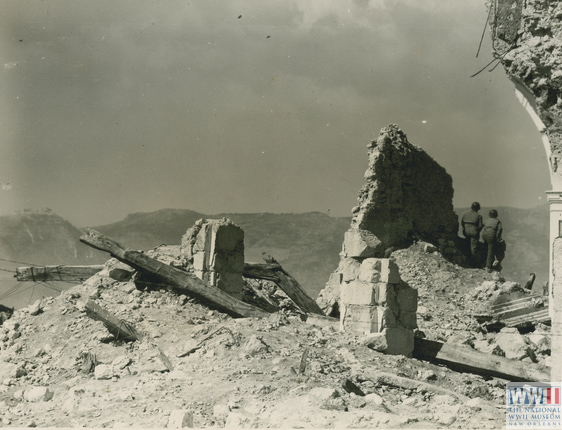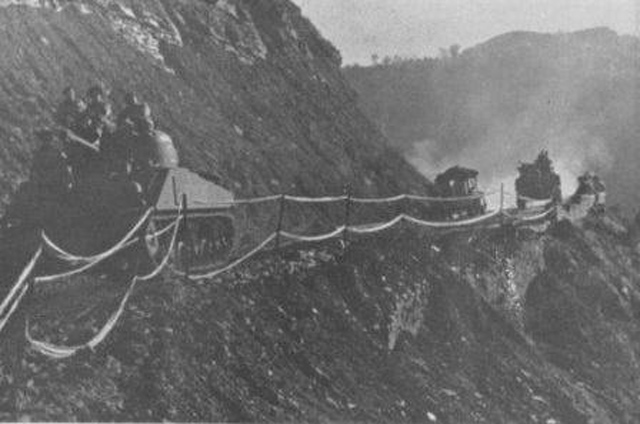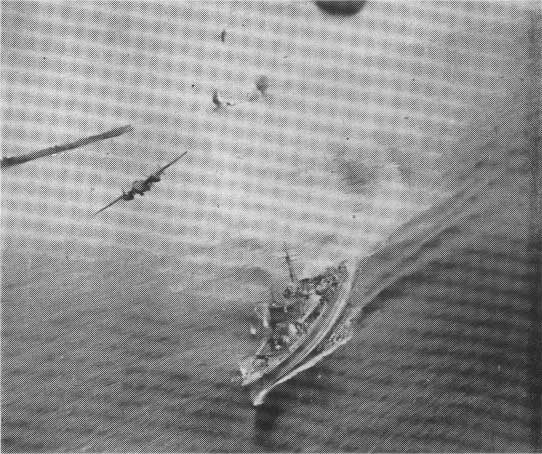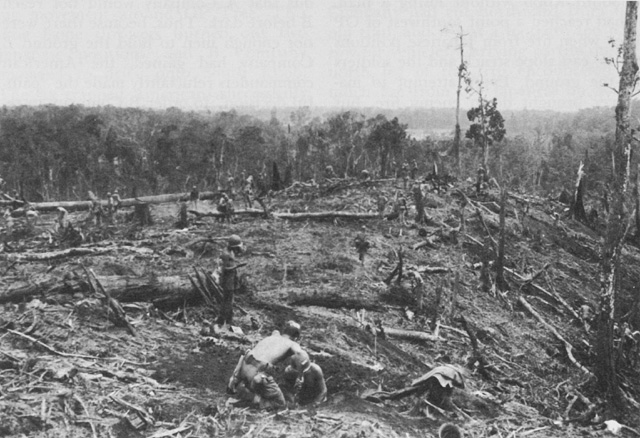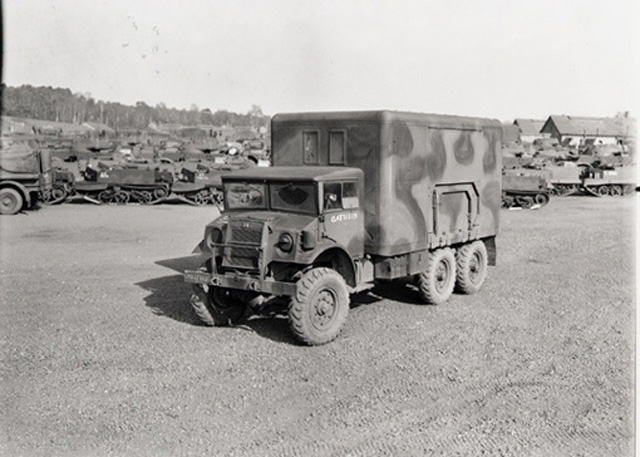Admiralty Islands
The US 8th Cavalry begins to mop up the eastern part of Manus Island. The 7th Cavalry is to eliminate the main enemy positions on the island along the Rossum road. [Air Operations, Central Pacific
VII Bomber Command B-24s attack Wake Island.
[Air Operations, CBI
BURMA- USAAF transports diverted from the Hump ferry route begin airlifting Indian Army troops to the Arakan front in Burma, where the fresh troops are used to deter a Japanese Army ground offensive.
- More than 20 490th Medium Bomb Squadron B-25s and 459th Fighter Squadron P-38 fighter-bombers attack Wuntho. 3 B-25s attack Indaw. 2 B-25s attack dumps and Japanese ground troops in the Mogaung Valley. More than 20 10th Air Force A-31s attack Japanese ground positions and occupied villages in the Chin Hills and along the Chindwin River. 16 P-51s attack the airfield at Meiktila.
- 2 11th Medium Bomb Squadron B-25s, escorted by 9 449th Fighter Squadron P-38s and 2 51st Fighter Group P-51s, sweep the Yangtze River at low level. 1 P-38 destroys a locomotive near Anking and another strafes a river steamer.
Air Operations, Europe
- There is a night raid on the northeast coast of England with Hull being the intended target. 9 planes are lost.
- In Operation STRANGLE the MAAF begins a 3-week all-out offensive against the Italian railway system, designed to isolate German forces in Italy. Fighter-bombers and medium bombers attack bridges, viaducts and railroad off-loading points while the heavy bombers attack marshalling yards, repair shops and junctions in northern Italy. Secondary targets include harbors and coastal shipping. 19,460 tons of bombs are dropped in March. In April and May Operation STRANGLE merges into the air phase of Operation DIADEM (see May 11), when 51,500 tons of bombs are dropped. Great damage is done but bad weather and multiplicity of targets 'cheats' an ambitious plan.
Evening Ops:
- 9 Mosquitos are sent to Berlin, 8 to Düsseldorf and 4 to Aachen, 19 Stirlings lay mines off the Dutch and French coasts, there are 4 RCM sorties, 3 Serrate patrols and 6 OTU sorties.
- 1 RCM Wellington is lost.
FRANCE:
- 173 1st and 3rd Bomb Division B-17s, escorted by P-47s, attack V-weapons sites.
- 20 78th Fighter Group P-47s, escorted by 10 other P-47s, dive-bomb the Gilze-Rijen Airdrome.
FRANCE:
- During the morning, 16 9th Air Force P-47 dive-bombers attack a Luftwaffe airfield near Boulogne-sur-Mer.
- 152 IX Bomber Command B-26s attack V-weapons sites around St.-Omer.
- During the afternoon, 65 IX Bomber Command A-20s attack the St.-Omer V-weapons sites again.
ITALY:
- 12th Air Force B-25s attack the marshalling yard at Avezzano, a bridge and the marshalling yard at Orte, and a bridge near Orvieto.
- 12th Air Force B-26s attack a road bridge near Arezzo and port facilities at San Stefano al Mare.
- XII Air Support Command A-20s attack tank repair shops near Tivoli.
- XII Air Support Command P-40s and P-47s attack gun emplacements and troop concentrations near the Anzio beachhead battle area.
AUSTRIA:
- Although unable to reach their target at Steyr because of bad weather, a total of 234 15th Air Force B-17s and B-24s attack the Klagenfurt Airdrome with 589 tons of bombs.
- 76 B-24s attack the Graz Airdrme with 183 tons of bombs.
- 12 B-24s are downed at Graz, 6 B-24s are lost at Klagenfurt, including 2 lost in a collision
- 15th Air Force B-24s attack marshalling yards at Knin and Metkovic.
ITALY:
- Components of the MATAF, including the 12th Air Force, are directed to expand their ongoing attacks against Axis lines of communication throughout Italy by targeting ports, rail lines, and marshalling yards. As previously mentioned, this is Operation STRANGLE.
Air Operations, New Guinea
- More than 100 5th Air Force B-24s, B-25s, A-20s, and P-47 fighter-bombers attack the Wewak area. B-25s, P-39s, and RAAF aircraft attack the Alexishafen, Hansa Bay, Madang, and Nubia areas. P-40s attack Garove Island (Bismarck Archipelago). 40 V Bomber Command B-24s, 56 B-25s, 33 A-20s, and numerous P-38 fighter-bombers destroy a Japanese convoy returning to Hollandia from Wewak. 2 A-20s are lost in a collision during the convoy attack.
- A 348th Fighter Group P-47 downs a Ki-43 'Oscar' fighter over Wewak at 0955 hours.
Battle of the Atlantic
The German submarine U-1059 is sunk by aircraft from the US escort carrier Block Island (CVE-21) in the Atlantic area.
| Class | Type VIIF |
| CO | Oberleutnant zur See Günther Leupold |
| Location | Atlantic, SW of Cape Verde Islands |
| Cause | Air attack |
| Casualties | 47 |
| Survivors | 8 |
CBI
BURMAIn the northeast sector, a detachment sent from the British and Chinese strongpoint at Fort Hertz occupies the village of Sumprabum. The 2nd Battalion and a portion of the 3rd Battalion of the Marauders, supported by the Kachin Rangers, establish a road block on the Kamaing Road. The remainder of the 3rd Battalion, the ORANGE Combat Team, provides security against a Japanese surprise attack.
In the central sector the Indian 5th Division moves, partly by train and partly by air, into the area where the Japanese pressure is strongest.
[Eastern Front
Konev's 2nd Ukraine Front forces reach and crosses the Dniestr near Yampol capturing Soroki a little to the south. Northwest of Konev's forces the German strongpoint of Mogilev-Podolsky is taken by assault by Soviet divisions converging from northeast and southeast. Near Dubno the Russians also take the town of Krzemieniec(Kremenech?).
CENTRAL SECTORThe 1st Belorussian Front launches a limited attack north of the Pripet Marshes.
SOUTHERN SECTORKovel falls to the 47th Army of the 2nd Belorussian Front after a brisk battle. This army has been deployed on the Front's left wing in order to strengthen the westward thrust. The 2nd Tank Army takes Soroki while the 6th Tank Army reaches the Dniestr on a broad front around Mogilev-Podolsky. Raus' 1st Panzer Army is virtually isolated by these deep Soviet thrusts, being hemmed in between Mogilev Podolsky and Tarnopol.
DIPLOMACY: HUNGARYPremier Kallay flees to Turkey as German units cross the border to bring Hungary under military contro. Operation MARGARET is successfully carried out as the Ostheer secures its lines of communication for Army Group South.
[Hungary
In Operation MARGARETE I (PANZERFAUST?) the Germans move into Hungary to prevent a collapse and ensure a line of retreat for their forces and continued access to the oil resources. It is also to forestall Hungarian attempts to make peace with the Allies. Prime Minister Miklos Kallay resigns and Dome Sztojay, the Ambassador in Berlin, forms a collaborationist government.
German forces occupy Hungary under an operation codenamed MARGARET. Ever since the Hungarian Army suffered huge losses around Stalingrad in early 1943, Hungary has been a lukewarm member of the Axis. Indeed, from April 1943 Premier Miklos Kallay has committed only a small number of poorly armed troops to the Axis war effort. Hitler has received reports proving that Hungary has been clandestinely dealing with the enemy and, in mid-March, Himmler learned from agents in Budapest that Kallay was advocating the sabotage of German military trains running through Hungary to Manstein's and Kleist's army groups on the Eastern Front. In view of all these things, and fearing that Hungary might conclude a separate peace, Hitler has ordered the occupation of Hungary and will force the government to increase its contribution to the war effort. Kallay flees to Turkey. Dome Sztojay, a pro-Nazi, becomes the new prime minister. His government will jail political leaders, dissolve the unions and resume the deportation of Hungarian Jews to the death camps.
It also looks as if Rumania is about to collapse in the face of the Russian advance and the BBC warns the Rumanian people that the hour of defeat is about to strike.
[Indian Ocean
The US freighter John A. Poor (7176t) is torpedoed and sunk by U-510 about 600 miles east of Madagascar. 25 of the 43-man crew and 9 of the 30-man Armed Guard are lost in the attack. Survivors are rescued the next day by the British freighter Fort Worth.
[Italy
In the Monte Cassino sector a German counterattack fails to re-capture Height 193, but the Allies advance slows down. The fighting is ferocious, although during one episode, reminiscent of ancient chivalry, both sides agree to a 2 hours' truce to allow the dead and wounded to be carried off the battlefield. The Allies lend their stretchers to the Germans and give chocolate to wounded men and stretcher-bearers.
[New Guinea
US destroyers repeat their shelling of the Japanese base at Wewak. After putting in at Wewak the Japanese supply convoy has put to sea again for Hollandia, but is surprised and destroyed by bombers and torpedo-aircraft of the US 5th Air Force.
[Pacific
The US destroyer Daly (DD-519) sink the Japanese auxiliary submarine chaser CHA-10 off Mushu, Wewak.
[Images from March 19, 1944
|
|
|
|
|
|
Burning New Zealand Ammunition Dump |
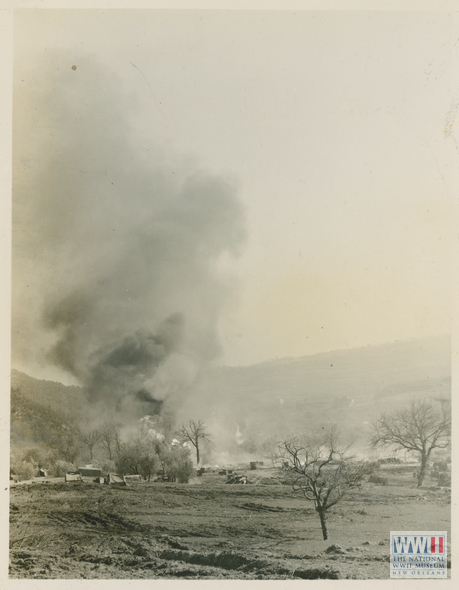 |
